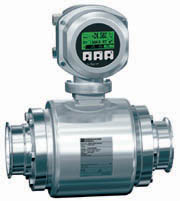
Yet, how fast, how quick, how clean do you need it to be?
To answer that question, you first need to distill the benefits of current flowmeter technology.
Today's flowmeters with digital outputs can help food producers do what many in the chemical, pharmaceutical, and petrochemical sectors have been doing for years-get tight control over processes and save money by metering the correct amount of ingredients into a batch. This translates into fewer wasted and thrown-away ingredients and more consistent product results.
According to John Martin, food and beverage marketing manager at Micro Motion, "Beverage producers value Coriolis [meters] as they can now blend their products on the fly. The high accuracy (0.1%) of Coriolis flowmeters makes this possible, and the added benefit of monitoring dissolved sugar content of the raw materials with a Coriolis meter helps to adjust blend rates when changes occur to raw inputs."
Getting this data out of the meter takes a smart device-level interface, and according to Martin, it's usually DeviceNet in the U.S. and Profibus DP in Europe. This is not to suggest that every manufacturer realizes the advantages of device-level networks-Martin still sees the lion's share of requests worldwide for the less communicative analog or pulse outputs.
According to Bob Ksiazek, product manager for flow at Anderson Instrument Co., those who are currently implementing fieldbuses are large corporate processors who are gutting their buildings and putting in new processes, thereby realizing the benefits of a fieldbus system. What will drive fieldbus implementation for smaller companies will be required documentation on the process, that is, being able to track a batch and have the assurance that each procedure occurred on the product-whether it's pasteurization or adding preservatives. The most convenient way to complete this would be through a bus system-as opposed to paper and clipboard.
For example, Jens Quist, automation engineer for Aarhus Olie's vegetable oil plant in Aarhus, Denmark, picked Emerson's PlantWeb architecture, which includes Micro Motion flowmeters, Fisher control valves with FIELDVIEW digital valve controllers, and Rosemount temperature transmitters. With diagnostics from the flowmeters and other sensors, calibration data, and configuration information, the plant reduces maintenance costs by initiating a predictive maintenance system.
Even if you don't have a fancy device network or plant local area network, you can still take advantage of the latest technology to save money. For example, Steuben Foods Inc., a contract manufacturer of aseptic products, has about 20 storage silos with a total inventory of 4 million pounds of product and 15 production lines. With product constantly on the move and with a different specific gravity for each product, getting a handle on product usage and loss was next to impossible. The solution was simple and cost-effective: Mount an Endress+Hauser Coriolis mass flowmeter on a wheeled cart and measure the content of each tank as it is filled and later emptied. This simple measurement revealed two things. First, the truck scales used for incoming supply were inaccurate. Second, Steuben's loss improvement team estimates that the return on investment (ROI) for the flowmeter was about one month, due to better inventory tracking.

Magmeter appeal
According to Bernd Schumacher, Krohne Meßtechnik GmbH food and beverage industry manager, magnetic meters (magmeters) are the most popular flowmeters in the food and beverage industry worldwide. Schumacher explained that food manufacturers often close small production facilities and combine the throughputs into larger facilities, resulting in much larger pipe sizes of up to 6 inches or more. The meters still have to be sanitary and easy to clean, and maintenance and turn-down times must be shorter. Magmeters today offer accuracy to 0.2% of reading, are hygienic and easy to clean (because of their liners,) and meet NSF 3A and EHEDG specs.Michael Kohlmann, Siemens Process Solutions Division product manager for magnetic flowmeters, has seen two areas where flowmeter business has taken off: the brewing and canning (fruits and vegetables) industries. Since magmeters have no obstructions or moving parts, and are available with various liner materials for sanitary use, magmeters offer many advantages over other technologies. Here, as in the chemical industry, liner materials have to withstand harsh use, including the caustics and acids used to perform CIP. The main difference, however, is the sanitary ratings and the use of Tri-Clover or Tri-Clamp process connections in the food industry.
"The food and beverage industry as well as the pharmaceutical industry," agrees Rex Mann, Flow Technology product manager, flow products, "are looking for meters with smooth inside surfaces, no cracks, crevices, or 90 degree bends where bacteria can get a foothold to grow." That's why the use of the tri-clamp styles in an end connection is important. Bores have to be beveled to match piping inside diameter to eliminate steps or bumps. And meters have to withstand high-temperature steam under high-pressures.
Precision of Coriolis
One thing all vendors and users of Coriolis meters agree on is the high accuracy they offer, typically 0.1% and the need for cleanliness. As Chuck Strawn, VP and general manager of Actaris points out, "Blending accuracy will often determine the quality of the final product, and any error translates to lost production." The disagreement between vendors is on the design-the old bent tube versus straight tube argument. Yet, cleanliness also remains an important issue.Michael Sherenian, product manager, mass flowmeters, Siemens, confirms it. He says his food and beverage users are interested in two issues with Coriolis meters: self draining/self filling and ease with which it can be cleaned. The obvious importance of self draining and self filling is that if there is any product left in a line when a process is stopped, you have potential contamination issues. Perhaps it's no surprise that cleanliness follows suit as the next concern.
While there's been some user interest in applying straight tube meters, the configuration of the tubes should be of secondary interest when compared to the ability to clean them properly. In theory, a single straight tube design should offer performance as good or, in some cases, better than the top bent tube or dual tube designs on the market, says Krohne's marketing manager, Liesel Oliveira. The benefit to the food industry is that this design offers the lowest possible pressure drop.
It is, however, the entrained air that worries Invensys flow specialist, Wade Mattar. He tells the story of a senior engineer at a specialty chemicals producer who believes process engineers spend more time trying to resolve problems with Coriolis meters than all the other types put together. And these problems arise from two-phase flow-not at all uncommon in the food industry. Mattar said that Invensys' own analysis shows that up to 92% of all Coriolis measurement problems are due to entrained air or gas, yet in the vast majority of cases two-phase flow is not even recognized as a problem.
Coriolis technology is highly accurate in single-phase flow but two-phase flow boosts the error rate to 20% or higher. At low levels of two-phase flow, conventional Coriolis meters tend to under predict flow; at higher levels, they tend to over predict. Some companies, says Mattar, have actually addressed the problem through marketing, by promoting entrained air as a product feature. This is especially possible in beauty and bath, food, and dairy products, where presence of bubbles in a clear tube, for example, becomes part of the packaging. Moral of the story: Know your application before you purchase your meter and be sure to interview your Coriolis vendors carefully if you think entrained air may be a problem.
According to Martin, since all food and beverage recipes are based on mass, not volume, the ability of Coriolis meters to measure mass directly, independent of changing density and temperature is a real benefit. One flowmeter can be used to measure accurately multiple fluids of varying density or viscosity without the need to recalibrate or adjust meter factors. For example, Algood Foods uses processing lines where fructose, maltose, and pectin are added at various stages of the cooking process in jams and jellies. Historically the ingredients were measured using positive displacement flowmeters based on volume. The ingredients' viscosity varied significantly with incremental temperature changes, so it made sense to measure the sweeteners and pectin flow based on mass, tightening the control and keeping the products much more consistent.

Other options
There are many flow measurement applications within the food and beverage industry where a flowmeter cannot be justified via ROI. In many of these cases, says Jeff Deane, chief technologist at Fluid Components Intl., consideration of a thermal flow switch will provide the necessary ROI justification. For example, if knowing product is moving through a pipe is more important than the amount of product moving, then a flow switch should be specified instead of a flowmeter. Thermal switches can provide dual-parameter measurement, process flow and temperature, and can service some unique applications such as the detection of agitation, foam, and reverse flow.A well-accepted alternative to the Coriolis and magmeter, according to Anderson's Ksiazek, is the positive displacement meter, with price and accuracy falling roughly between the two. A lower-priced alternative to the Coriolis meter, it is typically good in oils and sugar line applications, for example in ice cream manufacturing where magmeters are used for the cream and milk, and positive displacement meters for the sugar line.
Though positive displacement meters have seen long-standing service in the food and beverage industry, Deane suggests that thermal technology for metering gas flows offers increased reliability and much less maintenance because there are no openings to foul, no moving parts to wear, clog, or seize, and no pressure drops. Thermal flowmeters provide direct mass flow rate measurement at a lower cost because they compensate for changes in gas temperature or pressure, eliminating the need for other sensors in the line. Typical accuracy for these devices is ±0.5% fs with a repeatability of ±0.5%.
When you're concerned about product that's expensive, the cost of Coriolis can be written off pretty quickly. But if the decision is between a magmeter and Coriolis, take a little advice from Siemens' Kohlmann: "Price doesn't always indicate a better flowmeter. Look at the requirements for the application. If the application requires 0.1% accuracy, don't try to go on the cheap and install a magmeter. On the other hand, there is no need to put in a mass flowmeter if only 0.25 or 0.5% accuracy is required."
While smart flow transmitters with fieldbus networks are probably the wave of the future, there is almost unanimous agreement among our interviewees that smart networks will need to prove themselves to the food and beverage industry. Once management realizes that tracking production levels and inventory yields a competitive edge, there will be no question that smart device-level networks will couple into corporate networks as the prices of commodities increase.
For more information:
John Martin, Micro Motion, 303-530-8450,
www.emersonprocess.com/micromotion/
Bob Ksiazek, Anderson Instrument Co., 800-833-0081 Ext. 208,
www.andinst.com
Michael Kohlmann, Siemens Process Solutions Div., 215-646-7400 x 2520,
www.sea.siemens.com/ia
Rex Mann, Flow Technology, 602-437-1315,
www.ftimeters.com
Chuck Strawn, Actaris, 800-365-1224,
cstrawn@greenwood.actaris.com, www.actaris.com
Ola Wesstrom, Endress+Hauser, 317-535-2134, www.us.endress.com/foodinfo
Liesel Oliveira, Krohne USA,
978-535-6060 Ext. 105,
www.krohne.com
Wade Mattar, Invensys, 508-549-2067,
www.invensys.com
Sam Kresch, Fluid Components Intl., 760-736-6128,
www.fluidcomponents.com
